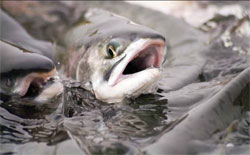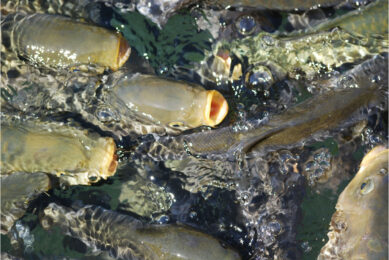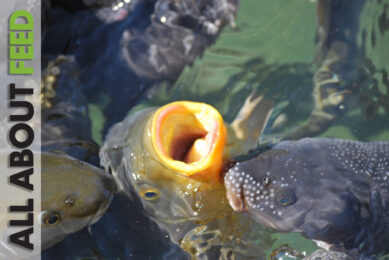Innovation key in aquafeed development

Aquaculture is the fastest growing agricultural sector with much of this growth occurring in developing countries where the need for high quality protein sources is highest. craig Browdy explores some of the challenges and opportunities in the development of the expanding aquafeed industry.
By Craig Browdy
Modern production of fish and other aquatic animals through aquaculture is a relatively young industry compared with traditional animal husbandry. The industry has evolved rapidly experiencing growing pains associated with the maturation process. In recent years, certification programs and regulatory foundations have been developed which reduce environmental footprints, advance socioeconomic development, and improve product quality while increasing production efficiencies and competitiveness. Aquaculture is a diverse sector producing hundreds of species in widely diverging production platforms. The largest production volumes come from traditional carp culture in Asia using simple plant based feeds and organic fertilizers.
At the other end of the spectrum, industrial aquaculture production technologies have been developed to produce high value species like salmon, shrimp and marine fish. In addition, large scale production of species like tilapia and striped catfish provide new alternatives to meet expanding demand for sustainable fish supplies. One of the most important keys to culture of any fed species is development of sustainable, cost effective, nutritionally complete feeds.
Obstacles
Aquaculture’s rapid expansion and great potential to meet human food needs represents an opportunity for those involved in aquafeed development. However, significant obstacles must be overcome in improving commercial aquatic animal nutrition. First, the great taxonomic and functional diversity of cultured aquatic animals is a growing challenge. Many species have complex lifecycles beginning with the fragile larval stages which require a nutritionally dense, digestible ration with very specific physiochemical requirements. For subsequent juvenile stages, feeds can often be designed to compliment contributions from natural productivity. With grower diets, cost efficiencies play an ever greater role. New research is also targeting finishing diets to enhance fillet quality. Fundamental understanding of the digestive physiology and nutritional requirements of different species of fish and crustaceans are often limited. As a new species enters the marketplace, sales prices begin high, dropping as markets become saturated when production efficiencies improve. Growers often become accustomed to first generation over-formulated diets relying on high fishmeal and fish oil inclusion rates.
Better designed feed
Today, in the most successful sectors, the industry is facing a complex transition to better designed feeds. These diets are developed based on improving understanding of nutritional requirements, better analyses of alternative raw ingredients, and use of advancing technologies. Innovations include water stable supplements, organic minerals, ingredient pretreatment, gut environment modifiers and enzymes, all of which offer opportunities to cost effectively enhance the farmer’s bottom line. It is the emphasis on reducing cost while increasing returns which will allow more sustainable feed technologies to enter and become established in this evolving marketplace. Aquafeed development is in some ways very similar to the history of development of prepared feeds for terrestrial agriculture. Over the past 50 years, terrestrial rations have reduced or eliminated use of fishmeal as the price of this limited commodity has risen. Formulations have been consistently improved based on a fundamentally improving understanding of the digestive physiology and nutritional requirements of poultry, ruminants and swine.
Selective breeding
One of the key accomplishments has been the ability to continue to meet the nutritional demands imposed by performance enhancements and physiological challenges resulting from aggressive selective breeding programs. With recent advancements in development of molecular genetic tools, the physiological demands of better growing stocks will continue to increase along with more powerful scientific methods for the fine tuning of animal feed development. All of these trends have direct relevance to aquafeed advancement. In fact, many of these processes are occurring concurrently and, in some cases, at a faster pace. On the other hand, there are some fundamental differences which must be understood in the unique context of aquaculture. For aquaculture species, feeds must be water stable. Environmental variables directly influence nutritional demands as the animals are cold blooded and they often face unique osmoregulatory challenges. Clearly, the number and variety of target species adds significant challenges in that research and development efforts must split between very different animal models. Thus, some of the most basic requirements remain undefined for many highly significant species. Meeting the needs of growers facing shrinking profit margins will depend upon the successful paradigm shift from formulation on the basis of ingredients to feeds based on a sound fundamental understanding of nutrition and physiology of the animal. This transition is well on its way with species like Atlantic salmon, tilapia, white shrimp, and trout while much more work is needed for emerging species like striped catfish and some marine carnivores.
Fishmeal extention
One of the greatest challenges for aquafeed development is reducing reliance on marine protein and lipid sources. Aquaculture feeds represent about 4% of total animal feed production while consuming over 68 percent of global reported fishmeal production and over 82 percent of reported fish oil production. Moreover, continued growth of the sector has generated increasing price pressure on these limited commodities, particularly in El Niño years when supplies are limited. Higher prices coupled with increasing awareness of sustainability issues are resulting in decreasing inclusion rates and growing research into use of alternative protein and lipid sources. In general, aquatic species have high protein and lipid requirements and lower tolerance to carbohydrates in feeds. Depending upon the indiginous and target species, increasing use of vegetable proteins can limit availability of essential amino acids, cause problems with digestibility, increase concentrations of anti-nutritional factors, reduce palatability and affect physical properties of the feed. Many species, particularly marine carnivores, have high requirements for highly unsaturated fatty acids. Essential fatty acids such a DHA (docosahexaenoic acid) must be supplied from marine fish unless cost efficient new alternatives are developed.
Mineral nutrition
Much public and private research effort is currently being invested into solving these problems. Water stable sources of crystalline amino acids such as methionine will be in higher demand as fishmeal is replaced by soy and other plant proteins. Chelates of HMTBa, (2-hydroxy-4-methylthiobutyrate) a methionine analog are being increasingly incorporated into aquafeeds, offering an effective and reasonably priced alternative to protected sources of methionine. Organic minerals provide a more bioavailable alternative to inorganic trace minerals for meeting mineral requirements of various aquatic species. This is becoming increasingly important as antagonists such as phytic acid accompany use of soy and other vegetable proteins. Proper mineral nutrition is a critical performance requirement, particularly as improved fitness and immunocapacitation, vaccination and other strategies are used to combat the disease challenges which increase with higher production densities. Higher inclusion levels of mineral salts can cause increasing antagonisms and result in higher water pollution which can reduce environmental quality critical for aquaculture performance.
Alternative ingredients
Other new technologies are being developed to improve the digestibility and nutritional quality of feed ingredients. Protein concentrates, use of rendered ingredients and pretreatment with enzymes can offer higher quality alternative ingredients which can improve performance, offering effective options when return on investment is factored in with feed ingredient costs. Increased safe use of byproducts can be especially important in aquaculture feeds with typically high protein requirements. New sources of proteins oils from algae and microbes offer exciting alternatives for meeting amino acid and HUFA requirements. Use of enzymes which can act in the gut of the animal to improve digestibility, to minimize antinutritional factors or to release otherwise indigestible nutrients offer another exciting alternative. For example an increasing body of literature demonstrates efficacy of phytases in releasing phosphorus and improving mineral availability. What is needed is low cost enzymes which can function in the gut of cold blooded animals and are heat stable enough to withstand the rigors of the feed manufacturing process.
Gut focus
Emerging technologies for improving the gut environment are being rigorously studied and are beginning to be applied in aquaculture feeds. Use of probiotics in feeds, although successful in human and animal nutrition, are not well accepted in aquaculture. Improved delivery methods and better understanding of gut microflora of aquatic animals could change this in the future. Similarly, prebiotics essential oils and organic acids are being shown to change gut microflora, improving conditions for healthy gut flora while reducing concentrations of potentially pathogenic strains of bacteria. Ongoing research is exploring relationships between the gut environment and potential for transmission of a wide variety of pathogens which infect through the digestive system.
Production technologies
For feeds which must be distributed through the water, production technologies become critical. Pellet stability, leaching and physical properties are essential variables which must be controlled through the manufacturing process. Improved pelleting and extrusion production technologies along with attention to details like fine grinding, pretreatment, manufacturing and drying temperatures distinguish top quality feeds. Use of floating feeds for top feeding fish is an example of a feed technology which can vastly improve delivery and associated water quality, animal health and production efficiencies. New technologies for microextrusion offer alternatives for feeding young fish and shrimp.
Exciting time
It is an exciting time to be in the aquatic animal feed business. The pending release of the new NRC compendium on nutrient requirements, the increasing volume of research publications and the application of new research tools is providing more information for researchers and industry. The development of alternative protein and lipid sources, availability of new water stable supplements and use of enzymes are providing more options that ever for least cost high performance formulations. An improving understanding of interactions between gut environment, nutrition and disease are providing alternatives to antibiotic therapies and hold promise for helping to control other diseases by improving host immunity, fitness and digestive health. Exigencies of the marketplace will drive the industry along the same lines as livestock improving production efficiencies and allowing for greater output of high quality sustainable products. Aquaculture will need to provide an additional 29 million tons of food fish just to maintain current consumption levels by 2030. With the increasing awareness of the health benefits of seafood consumption, growing needs of expanding human populations and inherent limits to current animal protein production models, the increasing importance of aquaculture and aquafeeds will only accelerate. New and innovative nutritional technologies will be an increasingly critical link in supporting future sustainable expansion of the sector.
Source: FeedMix vol 18 nr 1, 2010











